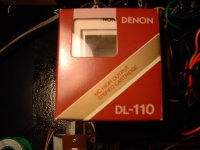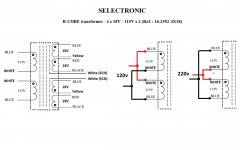My pics at post 15383 show my chassis which is a closed box without air vents. I measured the internal temp with the lid on --about 2" forward of the heat sinks, at a high sound volume -- at about 110 F. Say 10% accuracy could put it at 120 F, 50C. The exterior surface temp of the top is about 85F.
Based on my limited research this appears reasonable. H'ever, I could see about having some air vents machined or water-jetted into the (1/8") aluminum top. This could probably drop the internal temp +/- 20F. But I suspect getting the work done properly could be expensive.
Based on my limited research this appears reasonable. H'ever, I could see about having some air vents machined or water-jetted into the (1/8") aluminum top. This could probably drop the internal temp +/- 20F. But I suspect getting the work done properly could be expensive.
Well, if you can stretch to a Denon DL-110 it will be a nice starter. Almost all valve guys love Denons. 43dB gain configuration in the FSP will bring it up alright. Taste of MC, balanced tone.
Well look what I got,
 ,Would I need to change any parts thanks
,Would I need to change any parts thanksAttachments
Well look what I got,,Would I need to change any parts thanks
Good move, this one will make quite an upgrade over the low end AT MM.
 Best mode for it is 43dB gain. Some listen to the 110 at 1K-2K load, others at 5K-10K. 1.5K or 7.5K are good indicative tests. Typical 47K is not out of the question also. It depends on what load range will suit your amp+loudspeaker tone better. Is your FSP set at 43dB already if I remember well?
Best mode for it is 43dB gain. Some listen to the 110 at 1K-2K load, others at 5K-10K. 1.5K or 7.5K are good indicative tests. Typical 47K is not out of the question also. It depends on what load range will suit your amp+loudspeaker tone better. Is your FSP set at 43dB already if I remember well?My pics at post 15383 show my chassis which is a closed box without air vents. I measured the internal temp with the lid on --about 2" forward of the heat sinks, at a high sound volume -- at about 110 F. Say 10% accuracy could put it at 120 F, 50C. The exterior surface temp of the top is about 85F.
Based on my limited research this appears reasonable. H'ever, I could see about having some air vents machined or water-jetted into the (1/8") aluminum top. This could probably drop the internal temp +/- 20F. But I suspect getting the work done properly could be expensive.
It will also make it more responsive to the room ambient. Now it reaches an "oven" temperature. So if it is not expected to climb significantly in some other seasonal plateau during the year due to room ambient wide differences better let it be.
guys
what are you using after Salas NJFET pre to record your music In digital
I am looking for affordable analog to digital Interface
Some time ago, when I was considering to back-up all my vinyl to digital, I almost bought a Korg MR2 portable recorder. It seemed a reasonable solution in price/performance ratio. You can use it as a standalone device storing your recordings in a SD card. Output formats are PCM (up to 192kh/24bit) and 2.8Mh DSD. Even -God forbid !- compressed mp3.
My vinyl-to-digital project was delayed for a number of reasons. I never bought the Korg and I have no direct experiences on the real performances of the device. Maybe somebody here owns, or has owned, one of these and is able to enlighten us
Zoom models can be decent enough alternatives in lower price ranges but no DSD there
I haven't actually done any recording yet, but I gave my musician daughter one of these Product: DR-05 | TASCAM a while ago and plan to try to use it to rip vinyl at 24/96.
Zoom models can be decent enough alternatives in lower price ranges but no DSD there
Salas
thank you for Input
Is there a particular model from Zoom or other brand that you use (can recommend) to digitalize vinyls to a PC (with Win7 OS)
at first was Interested at RME ADI2 but searching web give many many other options (one of my searches was Behringer FCA202 fire wire Interface)
after your post I look at Zoom tac-2 which Is very promising but use Thunderbolt Mac Interface
I have the Zoom H2n field recorder that does not necessarily involve the PC during a take, it writes on SD card. Although it can be used as a USB audio interface too.
thank you for reply Salas, Artur5 and nezbleu
Merry Christmas and Happy New Year
No, I've only measured the transformers.Andrew, have you measured Rs on your 120VA R-Core with typical 10n and 150n caps?
Sent from my iPhone using Tapatalk
SELECTRONIC R-Core 4x18V; 115vx2 (Ref: 16.2352 4x18)
SELECTRONIC was nice and finally answered to my shipping damage report. They will send me one new trany as replacement for my broken one.
I made quick diagram that will help user to connect it correctly since SELECTRONIC does not provide that data.
SELECTRONIC was nice and finally answered to my shipping damage report. They will send me one new trany as replacement for my broken one.
I made quick diagram that will help user to connect it correctly since SELECTRONIC does not provide that data.
Attachments
Last edited:
Impedance question
I ordered an AT ART9 that should be here in a couple of weeks. Most loading recommendations are in the range of 100-200 ohms. However, a couple of people think something around 400 could be beneficial. I’ve got two other m/c carts that I may use in the FSP from time to time – one likes around 150; the other 330. I’ve run some calculations and arrived at a set of resistors that provide a nice selection between 100-200 and up to 400 (these are 270, 330, 390, 470).
Here’s the question: is there any design consideration where sound quality would be enhanced by putting the signal through only one resistor as opposed to three or four? For example, I could make 120 ohm by using 270, 290 & 470 (in parallel); or I could make 120 by passing the signal through a single 120 resistor. Employing all four resistors in parallel yields up to fifteen different combinations and gives a lot more flexibility.
Thanks
PS: I spend some time researching and sourcing the ART9. If anyone is interested, I could supply some of that info – either by PM or posting here. Just let me know.
I ordered an AT ART9 that should be here in a couple of weeks. Most loading recommendations are in the range of 100-200 ohms. However, a couple of people think something around 400 could be beneficial. I’ve got two other m/c carts that I may use in the FSP from time to time – one likes around 150; the other 330. I’ve run some calculations and arrived at a set of resistors that provide a nice selection between 100-200 and up to 400 (these are 270, 330, 390, 470).
Here’s the question: is there any design consideration where sound quality would be enhanced by putting the signal through only one resistor as opposed to three or four? For example, I could make 120 ohm by using 270, 290 & 470 (in parallel); or I could make 120 by passing the signal through a single 120 resistor. Employing all four resistors in parallel yields up to fifteen different combinations and gives a lot more flexibility.
Thanks
PS: I spend some time researching and sourcing the ART9. If anyone is interested, I could supply some of that info – either by PM or posting here. Just let me know.
Congratulations. Good choice. We will be happy to know about your adventures with the new cart. There is no technical difference between a single element value and a derived value by paralleling more elements. As for source impedance noise, it will only come from the cartridge since its internal value is much lower than its load. We could argue there is a switch and some little trace length used to parallel the elements but I don't think it can amount to something. Any little extra inductance from those things will be divided strongly by the paralleling again.I ordered an AT ART9 that should be here in a couple of weeks. Most loading recommendations are in the range of 100-200 ohms. However, a couple of people think something around 400 could be beneficial. I’ve got two other m/c carts that I may use in the FSP from time to time – one likes around 150; the other 330. I’ve run some calculations and arrived at a set of resistors that provide a nice selection between 100-200 and up to 400 (these are 270, 330, 390, 470).
Here’s the question: is there any design consideration where sound quality would be enhanced by putting the signal through only one resistor as opposed to three or four? For example, I could make 120 ohm by using 270, 290 & 470 (in parallel); or I could make 120 by passing the signal through a single 120 resistor. Employing all four resistors in parallel yields up to fifteen different combinations and gives a lot more flexibility.
Thanks
PS: I spend some time researching and sourcing the ART9. If anyone is interested, I could supply some of that info – either by PM or posting here. Just let me know.
You can try with several resistors or a linear trimmer, once you know the best resistance better use only one resistor to avoid Johnson noise.
The minimalistic argument for arriving to a preferable load value and using a single resistor would be to use it as R1, i.e. skip the input pads and switch, solder the input coax cable across R1. If only using one cartridge with no reason to change anything, also optimizing to have the most direct wiring in other words. Avoiding the selection circuitry's pcb loop area. But variable selection is handy luxury even with single cart for evaluating tone during the run in time or for compensating experiments with geometry. On the other hand if using expensive resistors, being confident about the load value can save enough $ by avoiding the selection bunch
- Home
- Source & Line
- Analogue Source
- Simplistic NJFET RIAA

